Synthesis of Dichloride-Diphenylacetonitrile Palladium and Metal-Polymer Composite Based on Uhmwpe
A. M. Nemeryuk and M. M. Lylina
Federal State Unitary Enterprise ”State Research Institute of Chemical Reagents and Pure Chemical Substances”(FSUE “IREA”), 107076, Russia, Moscow, Bogorodskiyval, 3
Corresponding author email: amnamn@mail.ru
DOI : http://dx.doi.org/10.13005/ojc/320218
Article Received on :
Article Accepted on :
Article Published : 13 Apr 2016
New complex of Pd (II) with phenylacetonitrile, suitable for use as a precursor of palladium nano particles in the composition of metal-based composite UHMWPE was obtained. The thermodynamic characteristics of metal-polymer composite, found the effect of nano particles of palladium in the crystallization processes in UHMWPE and other characteristics of the material.
KEYWORDS:UHMWPE; metal-polymer composite; nano particles Pd
Download this article as:| Copy the following to cite this article: Nemeryuk A. M, Lylina M. M. Synthesis of Dichloride-Diphenylacetonitrile Palladium and Metal-Polymer Composite Based on Uhmwpe. Orient J Chem 2016;32(2) |
| Copy the following to cite this URL: Nemeryuk A. M, Lylina M. M. Synthesis of Dichloride-Diphenylacetonitrile Palladium and Metal-Polymer Composite Based on Uhmwpe. Orient J Chem 2016;32(2). Available from: http://www.orientjchem.org/?p=15294 |
Introduction
Metal-polymer composites are of great interest due to the complex of properties that they exhibit. Thus, materials containing ultra fine particles of platinum metals exhibit catalytic activity, containing magnetic particles, such as particles of iron, cobalt, nickel, have the ability to shield electromagnetic radiation in the radio composites containing silver particles exhibit antimicrobial activity. Sometimes introducing into the polymer matrix of metal particles leads to a change of physico-mechanical properties of the composite, increasing durability, reducing the probability of crack formation, the temperature of operation increases.
For composites based on polymer matrix and ultra fine metal particles are often used method of impregnation. When this polymeric substrate saturated with a soluble organic medium a compound which, in the course of further reactions decomposes to release free metal. To this material was treated with ultrasound, UV radiation, is subjected to various chemical influences.
In order to obtain new materials with interesting properties for practical use, the composite materials have been studied, obtained by impregnation on the basis of UHMW polyethylene particles and palladium [1].
Processing UHMWPE products made in different ways, but the main method of processing is hot pressing. Thus UHMWPE powder is exposed to external pressure at temperatures above the melting point of the polymer, typically about 200°C. The temperature rise above this value leads to undesirable thermal degradation processes that result in reduced physical and mechanical characteristics of the material. For use in industrial processes necessary to apply chemical transformations leading to the formation of metal particles in the thermal destruction of the starting compounds, the precursor decomposition temperature of the metal should not substantially exceed 200°C.
As compounds, palladium metal precursors used quaternary ammonium tetrachloropalladate, palladium carboxylates such as palladium acetate, complexes of Pd (II), formed nitriles, isonitriles and alkenes. In [2] describes the preparation of metal-polymer composite by impregnating polystyrene various palladium complex compound wherein ligands are used as aliphatic and aromatic nitriles, and alkene nitrile blend. The authors found a correlation between the nature and character of the complex used in the polymer matrix particles of palladium. It was shown that the higher the lipophilicity of compounds of palladium, the greater the amount of metal possible to introduce into the polymer matrix and for the most lipophilic compounds is not observed the formation of particulate metal, and continuous layers covering the internal void in the structure of the polymer matrix[3-6].
Using (PhCN)2PdCl2 and (СH3CN)2PdCl2 not lead to optimal results, as lipophilicity acetonitrile complex appeared excessive and benzonitrile complex insufficient [6-8]. Based on these data, it was assumed that an optimum combination of properties, including lipophilicity and the decomposition temperature is necessary to use a palladium complex, wherein the ligand is used as the fatty-aromatic nitrile having in the molecule both an aromatic moiety and aliphatic. As such a compound, we used a complex of palladium dichloride and phenylacetonitrile.
Methods
Phenylacetonitrile, palladium chloride, benzene, hexane, were purchased from Sigma-Aldrich, benzene and hexane were dehydrated by prolonged boiling with phosphorus oxide and subsequent distillation, phenylacetonitrile was distilled in vacuo. UHMWPE Ticona GUR 4113.
Dichloride di(phenylacetonitrile) palladium
3 g of palladium dichloride was added to 20 g of phenylacetonitrile and stirred for 1 hour at room temperature. The mixture was then heated to 80°C and stirred for 6 hours. After cooling the reaction mixture to room temperature, the solution was filtered and to the filtrate was added 30 ml of a benzene-hexane 1: 1. Trituration crystallization, dichloride di(phenylacetonitrile) palladium isolated as yellow crystals. After standing overnight at 0°C, crystals were collected by filtration and recrystallized from benzene-hexane 1: 1. 2.78 g of the product obtained yellow crystals.
Calculated C 46,68H3,42 N6,80 Cl17,22 Pd 25,85, found С46,70 H3,39 N6,75 Cl17,46 Pd 25,7 decomposes at T> 200oC.
Impregnation dichloride di(phenylacetonitrile) palladium UHMWPE
138 g of UHMWPE powder with a particle size of 50-200 microns was mixed with 200 ml of a solution of 1 g dichloride di(phenylacetonitrile) palladium in benzene and stirred at 75°C for 12 hours. UHMWPE is filtered off and washed repeatedly with benzene. After removal of solvent residues in vacuum to yield a powder of UHMWPE containing 0.4-0.6% Pd.
Hot pressing of composite based on UHMWPE
UHMWPE powder containing 0.5% dichloride di(phenylacetonitrile) palladium incubated at 110°C for 40 minutes. Then pressed for 4 hours at a pressure of 10 MPa and a temperature (185-210)°C. The samples were then cooled to room temperature at a rate of 3-4°C / min.
Results and Discussion
The resulting samples were examined by scanning electron microscopy, and IR spectroscopy, differential scanning calorimetry.
To investigate the internal structure of the composites based on UHMWPE samples were cooled with liquid nitrogen and are made to prevent faults surface structure changes during sectioning. Images obtained by SEM are shown in Figure 1 and 2.
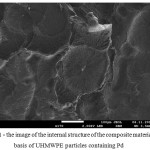 |
Figure 1: the image of the internal structure of the composite material on the basis of UHMWPE particles containing Pd |
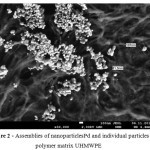 |
Figure 2: Assemblies of nano particles Pd and individual particles in a polymer matrix UHMWPE
|
IR absorption spectrum was recorded for dichloride di(phenylacetonitrile) palladium, Figure 3.
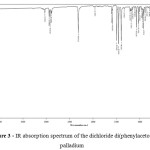 |
Figure 3: IR absorption spectrum of the dichloride di(phenylacetonitrile) palladium |
IR reflection spectra were obtained using a device based on the FT-IR spectrometer VERTEX 70 with the prefix ATR (ZnSe) Figure 4.
 |
Figure 4: IR reflection spectrum for a sample of UHMWPE containing ultrafine Pd particles
|
To determine the thermodynamic characteristics of the materials obtained were investigated by DSC, it was defined as the melting start temperature and the melting point of the composite, and the starting UHMWPE. It has been found that the introduction of palladium ultrafine particles leads to a slight decrease in the melting temperature (Figure 5 and 6).
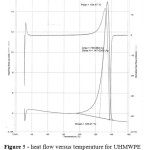 |
Figure 5: heat flow versus temperature for UHMWPE containing ultrafine particles of Pd Click here to View figure |
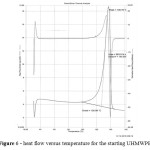 |
Figure 6: heat flow versus temperature for the starting UHMWPE Click here to View figure |
The results obtained in the course of research data indicate that dichloride di(phenylacetonitrile) palladium compound is suitable for use as a precursor of palladium nanoparticles to create metal-polymer composites based on polymers of low polarity, for example, UHMWPE. Sufficiently thermally stable substance and, unlike palladium carboxylates, it decomposes with the release of metal only at temperatures exceeding the melting temperature of the UHMWPE. According to the obtained SEM for faults material made after liquid nitrogen cooling, the metallic particles are the centers of the formation of spherulites regions of crystallinity in the polymer matrix UHMWPE. The size of the particles produced in this Pd ranging from 40 to 100 nm in the central regions of the spherulites also detected aggregates of nano particles. This confirms the assumption that formed during the thermal degradation of the polymer matrix palladium nanoparticles are centers of crystallization of UHMWPE, which occurs upon cooling of the material below its melting point. DSC showed a slight decrease in the melting point, which may indicate the influence of the introduction of the composite metal particles on the crystallinity of the polymer. On the other hand dichloride di(phenylacetonitrile) palladium has significant lipophilicity, which allows the impregnation of the polymer matrix to create a precursor concentration sufficient to provide metal-polymer composites containing up to 0.4-0.6%
Conclusion
An integrated connection dichloride di(phenylacetonitrile) palladium. It has been found that the interaction with the fine powder of UHMWPE in a medium boiling benzene impregnating polymer complex occurs. When hotpressing impregnated powder compact obtained samples of metal-polymer composite containing 0.4-0.6% Pd. Study of the composites SEM confirms the presence of metal in the composite particles of spherical shape with a size of 40-100 nm. The particles of palladium metal formed by heating in a polymer matrix, are the centers of crystallization of UHMWPE that influences packing of macromolecules in supramolecular aggregates.
Acknowledgements
Applied researches are carried out with financial support of the state by the Russia Ministry of Education and Science under Grant Agreement № 14.576.21.0004 of June 17, 2014. (Unique identifier for Applied Scientific Researches (project) RFMEFI57614X0004).
References
- Sing K. S. W., Everett D. H., Haul R. A. W.,Moscou L.,Pierotti R. A.,Rouquerol J.,Siemieniewska T. In Handbook of Heterogeneous Catalysis. Wiley-VCH Verlag GmbH&Co,Weinheim 2008
- Tsvetkova I. B., Matveeva V. G., Doluda V. Y.,Bykov A. V., Sidorov A.I.,. Schennikov S. V, Sulman M. G.,Valetsky P. M.,Stein B. D., Chen C-H.,Sulmanb E. M. and Bronstein L. M. J. Mater. Chem, 2012, 22, 6441-6448
CrossRef - Lamblin M., Nassar-Hardy L., Hierso J.C., Fouquet E., Felpin F.X.Adv. Synth. Catal.,2010, 352, 33
CrossRef - Lu J., Toy P.H. Chem. Rev.,2009, 109, 815
CrossRef - McNamara C.A., King F., Bradley M. Tetrahedron Lett.,2004, 45, 8239
CrossRef - Elson K.E., Jenkins I.D., Loughlin W.A. Tetrahedron Lett.,2004,45, 2491
CrossRef - Mansour A., Portnoy M., MolJ. Catal. A: Chem., 2006,250, 40
CrossRef - Bergbreiter D.E., Kippenberger A.M., Tao G. Chem. Commun.,2002,18, 2158
CrossRef

This work is licensed under a Creative Commons Attribution 4.0 International License.









